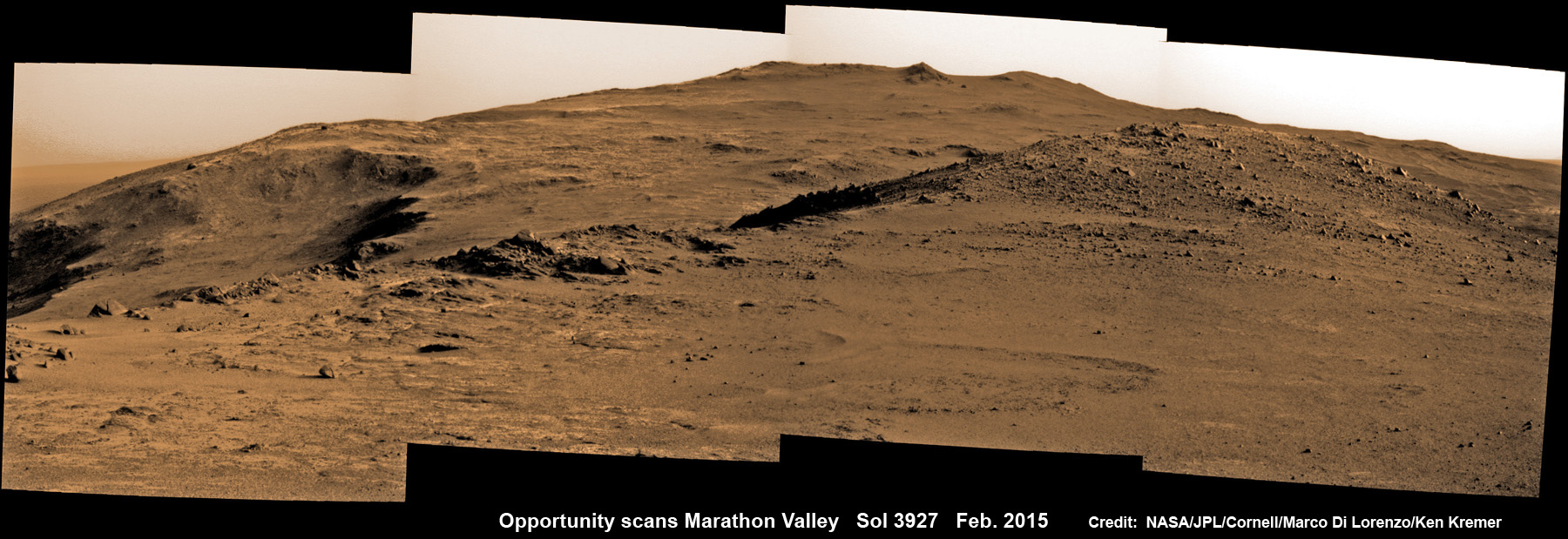
Opportunity has roved nearly the distance of a marathon runner’s race across the alien and rugged surface of Mars since she touched down on the fourth rock from the Sun 11 years ago!
As of today, Feb 12, NASA’s Opportunity Mars Exploration Rover is less than 220 yards (200 meters) shy of driving the equivalent of an Olympic marathon race during her 3930th Sol, or day, alive on the Red Planet and overlooking spectacular crater cliffs. See the view from Mars Today in our new photo mosaics herein. Since her mission was only planned to last for 90 Sols, she is 132 months into her three-month mission.
An Olympic marathon is 26.219 miles (42.195 kilometers), and the rover has driven 26.095 miles (41.995 kilometers).
And she will surpass that marathon feat shortly at a spot that could not be more appropriate: a place called “Spirit of Saint Louis Crater,” which is the gateway to a motherlode of Martian mineral treasures altered by ancient flowing water at “Marathon Valley.”
“’Spirit of Saint Louis’ crater is at the entrance to ‘Marathon Valley.’ Its named that because the rover will have traveled one marathon’s distance to reach it,” Prof. Ray Arvidson, the rover Deputy Principal Investigator of Washington University, told AmericaSpace.
Barely a month ago, on Jan. 6, 2015, Opportunity accomplished the incredible feat of climbing atop a Martian mountain summit at Cape Tribulation, located along the western rim of Endeavour crater. The peak stands about 440 feet (135 meters) above the local plains around the crater.
Vast Endeavour crater spans some 22 kilometers (14 miles) in diameter.

Now, a huge cache of long-sought-after, water-altered clay minerals providing clues to habitability for potential Martian microbes, if they ever existed, lies only dozens of meters away!
It’s the culmination of an impossible dream never foreseen during the nail-biting air-bag assisted touchdown 11 years ago, on Jan. 24, 2004, on the plains of Meridiani.
“When Opportunity was in its prime mission 11 years ago, no one imagined this vehicle surviving a Martian winter, let alone completing a marathon on Mars,” said Mars Exploration Rover Project Manager John Callas of NASA’s Jet Propulsion Laboratory, Pasadena, Calif. “Now, that achievement is within reach as Opportunity approaches a strategic science destination. What’s most important about the longevity and driving distance the mission keeps extending are not numerical thresholds, but the wealth of scientific information returned about Mars, made possible by these feats.”

Indeed, the six-wheeled robot has survived six utterly harsh Martian winters colder than Antarctica!
You can see the entire 11-year overland traverse of Opportunity in our exclusive route map below, along with photo mosaics from her current location created by the imaging team of Marco Di Lorenzo and Ken Kremer.
Opportunity has already established the off-Earth distance driving record when she smashed through the previous interplanetary “Olympic” record of 25 miles (40 kilometers) on July 27, 2014, held by the Soviet Union’s venerable Lunokhod 2 moon rover since the 1970s.
Multiple types of phyllosilicates clay minerals were detected at “Marathon Valley” from orbital observations gathered by NASA’s Mars Reconnaissance Orbiter (MRO).
Since departing the Cape Tribulation mountain peak, Opportunity has driven some 440 yards (400 meters) in a southerly direction toward the “Spirit of Saint Louis Crater” at the entrance to Marathon Valley.
Marathon Valley is a place of majestic cliffs and the clay minerals are indicative of an ancient wet Martian environment where water was more neutral and conducive to the formation of life, rather than harshly acidic.
Opportunity will initially conduct observations at “Spirit of Saint Louis Crater,” which is an impact crater, as the team assesses where to drive for up-close investigations around Marathon Valley.
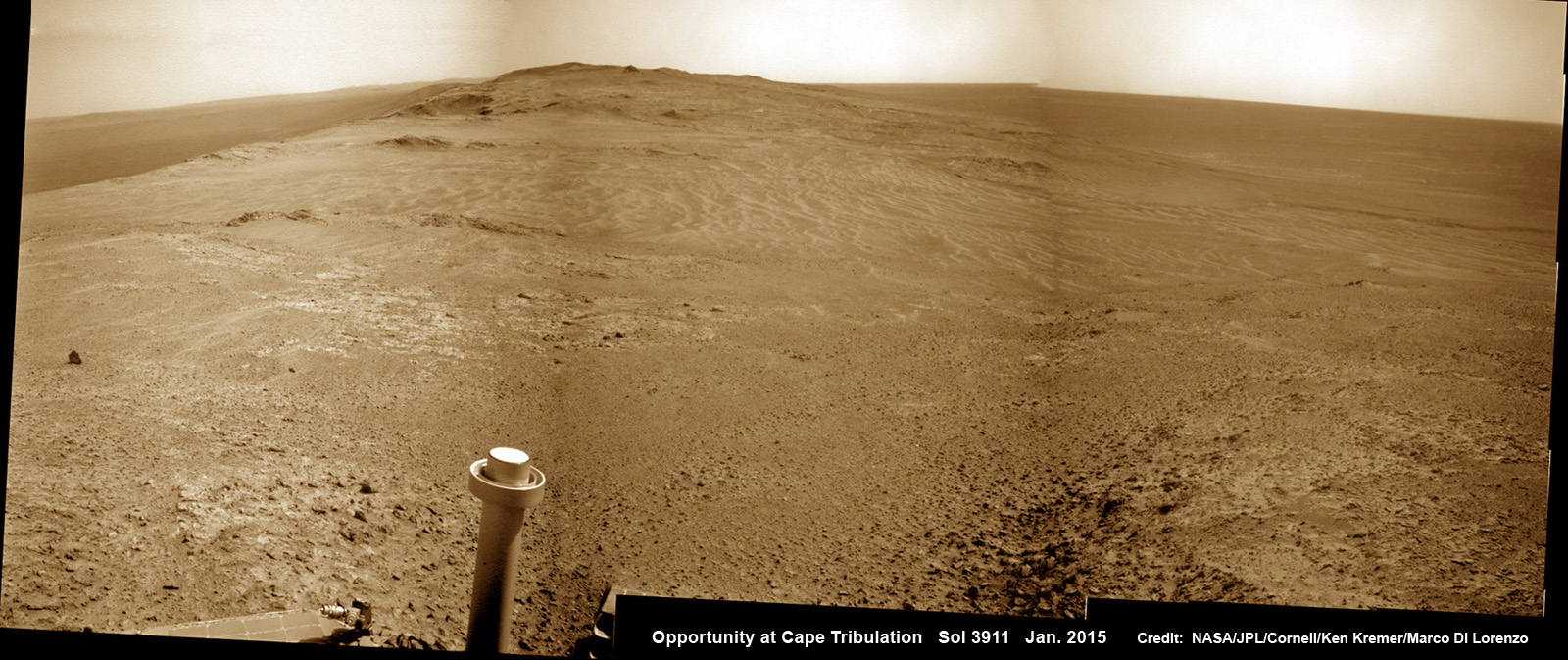
The intrepid robot reached the summit and carried out her recent science investigations over the past few months despite being somewhat “crippled” due to problems with the flash memory.
So the team is operating aging Opportunity in a mode that avoids use of the rover’s flash memory. They developed a workaround that involves storing the data gathered during each Martian day in volatile memory and transmitting that to one of NASA’s orbiters (Mars Odyssey or Mars Reconnaissance Orbiter) for relay back to Earth before the rover routinely goes to “sleep” each night to conserve energy.
“I feel really good about that. We managed to reach the summit of Cape Tribulation and take a spectacular panorama of Endeavour Crater there, all without using our flash memory,” Prof. Steve Squyres, the rovers Science Principal Investigator of Cornell University, said exclusively to AmericaSpace.
“It’s the mode of operation that has always been called ‘crippled mode,’ but I think we’ve shown that in that mode the rover is not crippled at all … it’s just a bit forgetful.”

Furthermore, all this recent climbing in “crippled mode” was accomplished during the most difficult part of the ascent, and moving regularly multiple times per week.
“I think this milestone is particularly significant because we accomplished the steepest and hardest parts of it in what we call ‘crippled mode.’ We’re having difficulties with our aging flash memory, and until we can correct the problem we’re operating the vehicle in a mode that bypasses flash completely,” Squyres elaborated.
So the team was resourceful in the face of a big challenge and developed workarounds to save the rover and the science!
“What that means is that after each sol’s activities, any data not downlinked immediately is lost forever. This requires a very different way of operating the vehicle, and the team has mastered it,” Squyres told AmericaSpace.
No one wants priceless data to be lost, and they are working on a software update.
“We think we’ve found a way to ‘mask’ the part of the flash that’s causing the trouble, giving us access to the rest of it and returning most of the flash to regular use,” replied Squyres.
“We’re testing this on the ground, and we’ll implement it on Mars when it’s safe to do so.”
Rover engineers hope to upload a software revision to enable resuming use of non-volatile flash memory in a few weeks that will restore Opportunity’s capability to store data overnight or longer, for transmitting later, according to a NASA update.
So far Opportunity has snapped over 200,610 amazing images on the first overland expedition across the Red Planet.
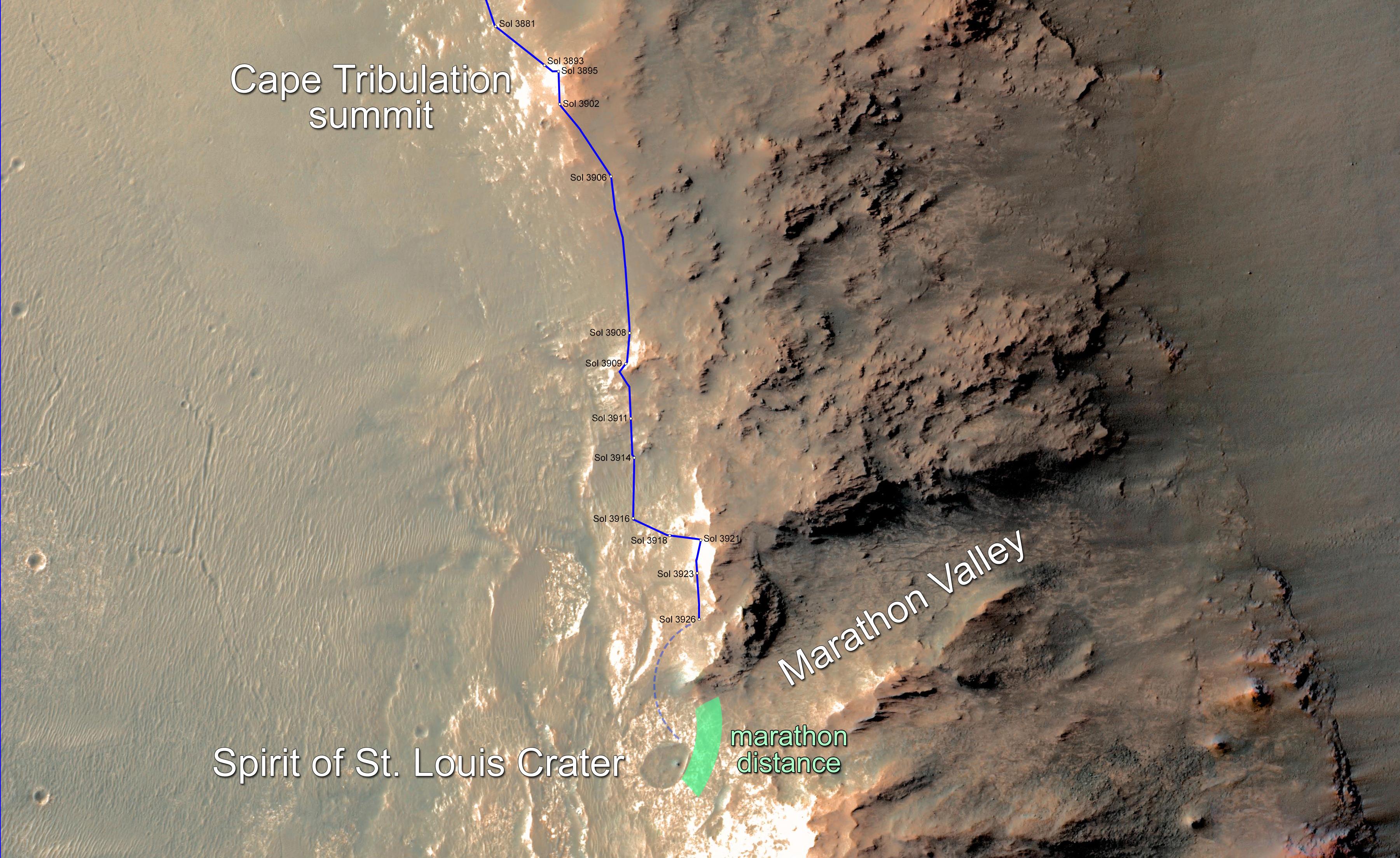
Despite all these accomplishments, the White House seeks to “Kill Opportunity.” Under the newly rolled out NASA budget proposal for Fiscal Year 2016, Opportunity would “cease operations” with funding being “zeroed out” as detailed in this recent AmericaSpace story.
The cost to operate Opportunity was just $14 million during 2014.
Meanwhile, younger sister rover Curiosity is taking “bites” from the base of another Martian mountain on the opposite side of the Red Planet. Read all about her new drilling campaign here.
Stay tuned here for continuing developments from Earth’s invasion fleet at Mars.
Want to keep up-to-date with all things space? Be sure to “Like” AmericaSpace on Facebook and follow us on Twitter: @AmericaSpace
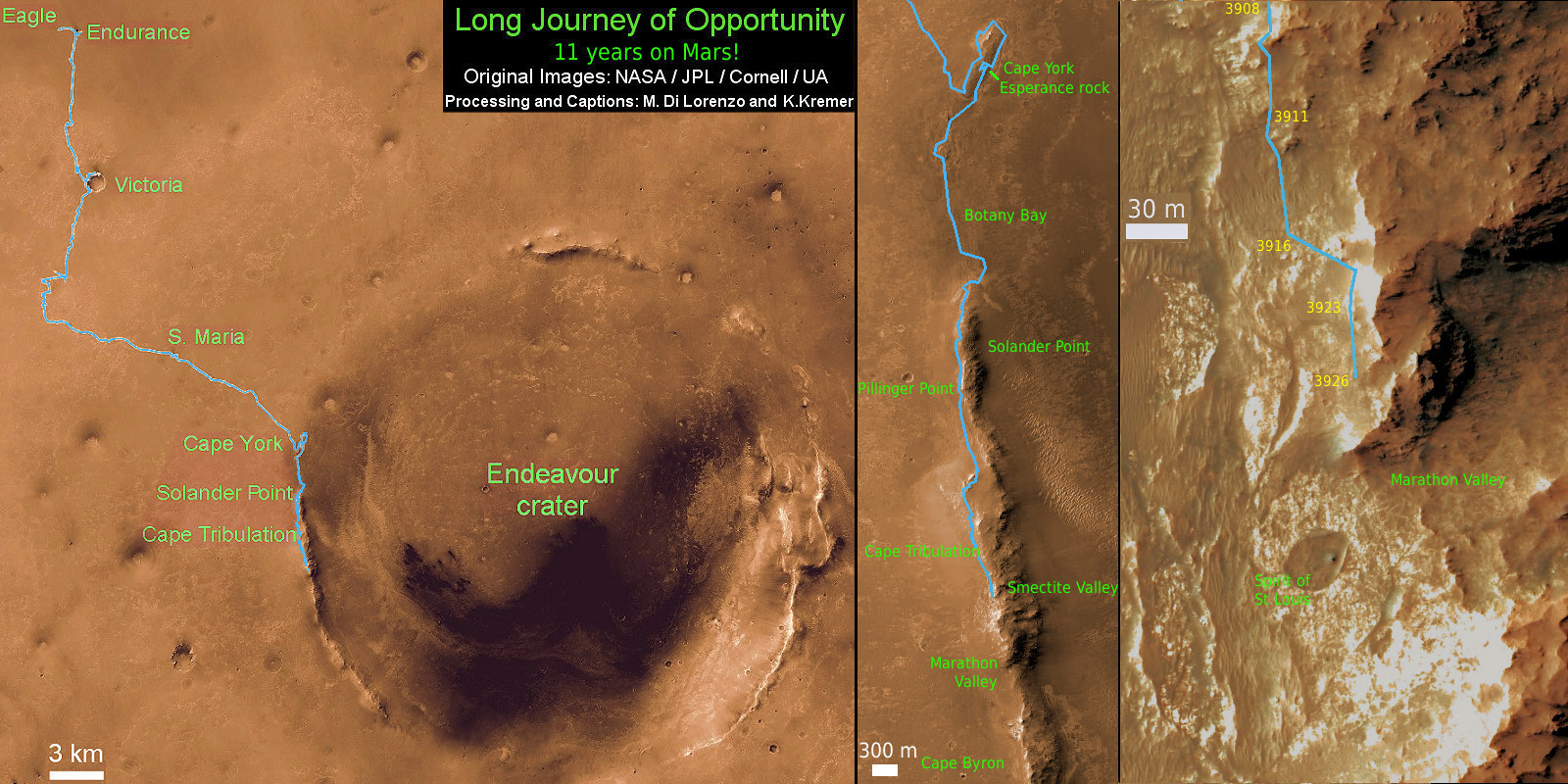
This map shows the entire path the rover has driven during 11 years on Mars and over 3926 Sols, or Martian days, since landing inside Eagle Crater on Jan 24, 2004 to current location just past the Cape Tribulation summit at the western rim of Endeavour Crater near Marathon Valley. Rover marked 11 anniversary on Sol 3911. Opportunity discovered clay minerals at Esperance – indicative of a habitable zone – and is searching for more on the road ahead at Marathon Valley. Credit: NASA/JPL/Cornell/ASU/Marco Di Lorenzo/Ken Kremer – kenkremer.com
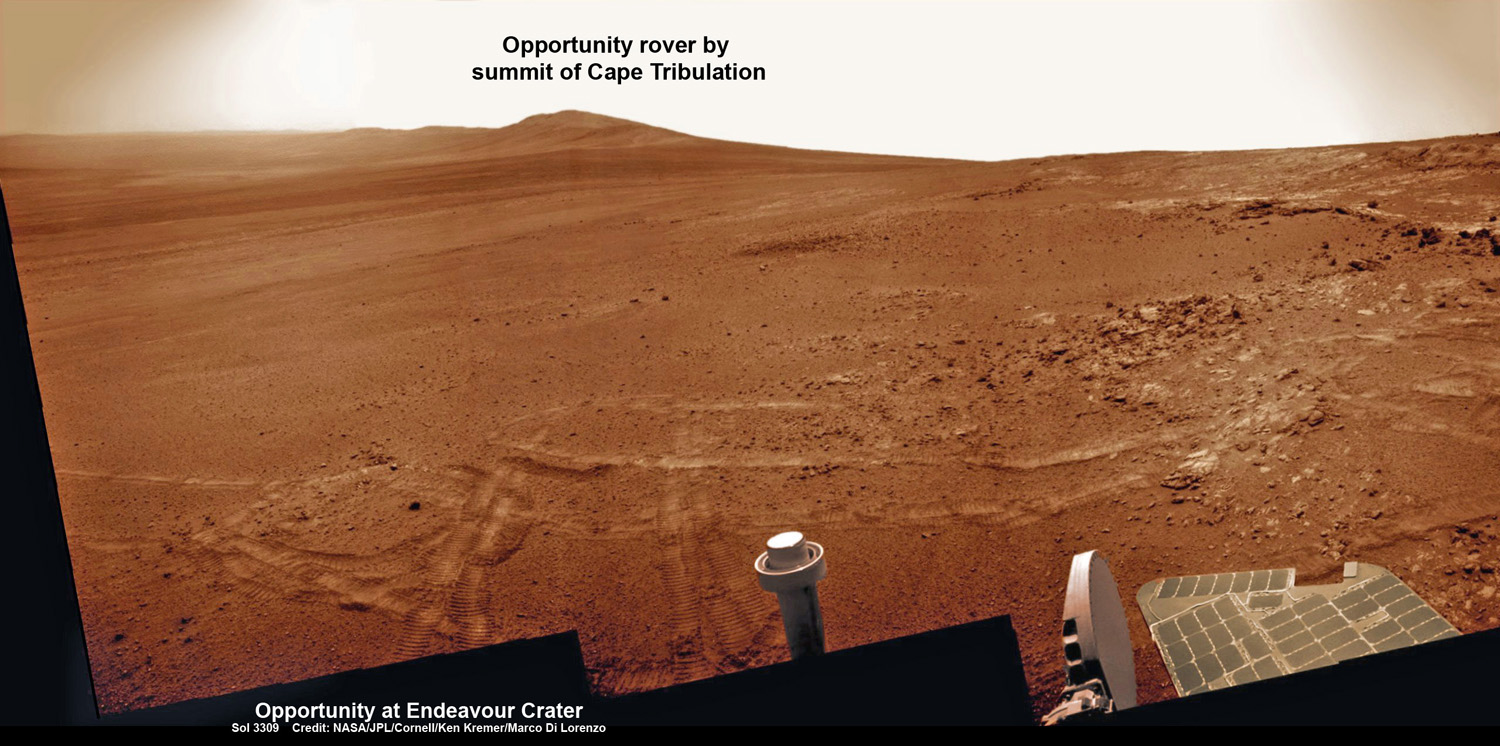




We are witnessing the incredible genius surrounding planetary and moon exploration of Mars and Titan as evidenced by the amazing work of the scientists and engineers. Developing “work-arounds” and image enhancement techniques, we are able to extend our knowledge of both heavenly bodies. It is absolutely stunning to read the descriptions and to view the images in both articles. It is a tribute to the dedication of all involved. Bravo!